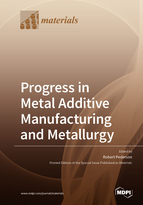Progress in Metal Additive Manufacturing and Metallurgy
A special issue of Materials (ISSN 1996-1944). This special issue belongs to the section "Manufacturing Processes and Systems".
Deadline for manuscript submissions: closed (30 April 2020) | Viewed by 68479
Special Issue Editor
Interests: future additive manufacturing; powder bed fusion process; directed energy deposition process; hybrid additive manufacturing process; Ni-based superalloys; titanium alloys; steels; aluminium; microstructure; defects; mechanical properties; metallurgy; mechanical testing; simulation; modelling; validation; qualification
Special Issues, Collections and Topics in MDPI journals
Special Issue Information
Dear Colleagues,
Research in additive manufacturing (AM) of metals has witnessed a dramatic rise in global attention during the past decade. Some AM processes have evolved from conventional welding processes, while others, such as powder bed fusion processes, have been developed with the specific intent of enabling the manufacture of complex 3D geometrical objects. One key feature of all AM processes is that material is only added where it is really needed, thereby permiting near net shape manufacture utilizing starting feedstock in powder or wire form, with virtually no residual material waste if all the unmelted material can be fully recycled.
The distinct heating–cooling cycles associated with various AM processes result in different as-built microstructures and varying types of defects, which are additionally governed not only by the process parameters used but also by the geometry of object(s) being built as well as by the local environmental conditions prevailing during processing. Consequently, in-process monitoring of different parameters is important to understand the process parameter–microstructure relationships during the layer-on-layer manufacturing. For low-stressed, statically loaded components, the microstructure determines the average mechanical properties. However, for cyclicly loaded critical parts, like aeroengine or turbine components, defects limit the lower bound of the mechanical properties and are, therefore, a major concern as they restrict the loading conditions during operation. In view of the above, post-build treatments like Hot Isostatic Pressing (HIP) that can minimize certain types of defects like porosity can become relevant, depending on the material and AM process in question. Other in situ/post-build treatment/hybrid solutions have also been considered, such as inducing residual compressive stresses in built material to reduce the influence of surface topography/defects/residual stresses on properties. From an implementation standpoint, the final quality of finished parts also needs to be ascertained using appropriate non-destructive evaluation (NDE) methods, which represent an area under active development.
It is thus apparent that AM involves a complex manufacturing chain spanning a number of different expert competences that have to be coordinated appropriately to enable successful economical serial production of AM components. Since such a complex knowledge chain is challenging for any single organization to internally complete, etsablishing collaborative networks that stitch together complementary competences is often a key enabler.
This Special Issue intends to address the latest progress in various facets of metal AM that constitutes the entire value chain. Topics include but are not limited to the following:
- Directed energy deposition processes (DED);
- Powder bed fusion processes (PBF, EBM, SLM, and more);
- Hybrid-AM techniques;
- Process parameter-microstructure/defects–mechanical property relationships;
- Advanced characterization of AM utilizing SEM, TEM, synchrotron radiation diffraction, neutron scattering, and more;
- Post-build/in situ treatments (HIP, HT, machining, shot peening, hybrid manufacturing, and more) and their influence on material properties and quality;
- In-line monitoring techniques for process-build evaluation and control;
- AM process modeling, including areas such as temperature history, phase transformation, precipitation kinetics, microstructure, defects, cracks, and residual stress/distorsion;
- Development of alloys customized for AM;
- Digitalization of AM.
I hope the comprehensive AM-related focus of this Special Issue will encourage submissions of manuscripts incorporating recent research findings in any of the above topics, as well as manuscripts focused on the complex chain of activities required for maturing AM into a serial manufacturing technique.
Prof. Dr. Robert Pederson
Guest Editor
Manuscript Submission Information
Manuscripts should be submitted online at www.mdpi.com by registering and logging in to this website. Once you are registered, click here to go to the submission form. Manuscripts can be submitted until the deadline. All submissions that pass pre-check are peer-reviewed. Accepted papers will be published continuously in the journal (as soon as accepted) and will be listed together on the special issue website. Research articles, review articles as well as short communications are invited. For planned papers, a title and short abstract (about 100 words) can be sent to the Editorial Office for announcement on this website.
Submitted manuscripts should not have been published previously, nor be under consideration for publication elsewhere (except conference proceedings papers). All manuscripts are thoroughly refereed through a single-blind peer-review process. A guide for authors and other relevant information for submission of manuscripts is available on the Instructions for Authors page. Materials is an international peer-reviewed open access semimonthly journal published by MDPI.
Please visit the Instructions for Authors page before submitting a manuscript. The Article Processing Charge (APC) for publication in this open access journal is 2600 CHF (Swiss Francs). Submitted papers should be well formatted and use good English. Authors may use MDPI's English editing service prior to publication or during author revisions.
Keywords
- additive manufacturing
- metals
- titanium alloys, Ni-base superalloys, steels, aluminium alloys, directed energy deposition processes
- powder bed fusion processes
- hybrid proceses
- wire
- powder
- recycle
- process parameters
- defects
- porosity
- lack of fusion
- microstructure
- texture
- characterization techniques
- microscopy
- synchrotron-/neutron- scattering measurements
- residual stress
- post build treatments
- heat treatment
- hot isostatic pressing
- shot Peening
- mechanical properties
- on-line/in-line monitoring
- process control
- process regulation system
- micro-/macro scale material/process modeling
- simulation
- validation
- qualification
- digitalization
- sustainability
Related Special Issue
- Additive Manufacturing: Alloy Design and Process Innovations in Materials (63 articles)







